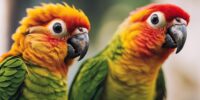What Is "Doga" and How Can It Benefit Your Pet?
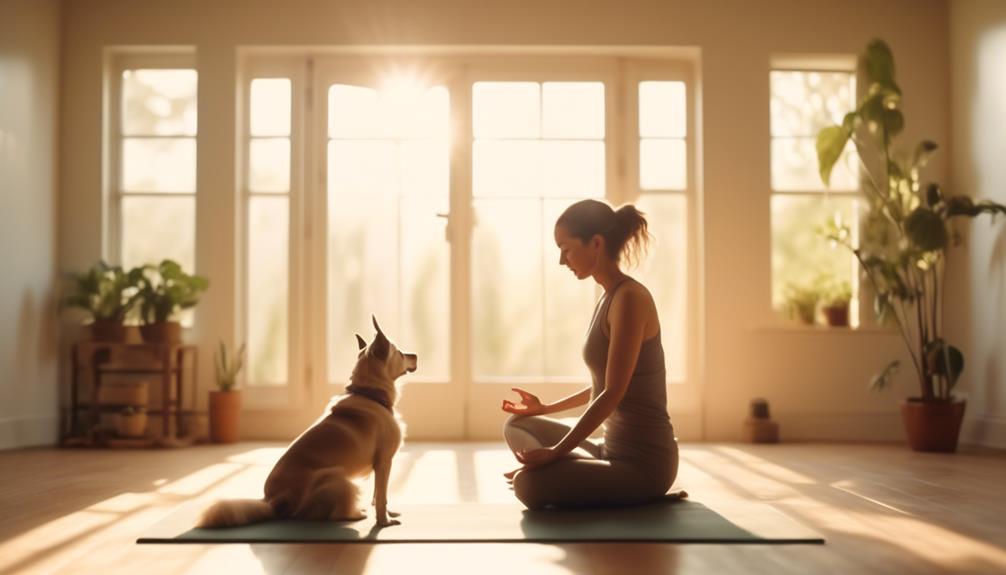
Doga is a practice that combines yoga and bonding with your pet. It provides physical and mental benefits for your furry friend while deepening the bond between you.
Doga involves practicing yoga poses and movements alongside your pet. This can include simple stretches, gentle massages, and even some partner poses.
The physical benefits of Doga for your pet include increased flexibility, improved circulation, and reduced stress. It can also help with weight management and overall physical fitness.
In addition to the physical benefits, Doga can also have positive effects on your pet's mental well-being. It can help reduce anxiety, promote relaxation, and enhance their overall sense of calm.
Doga also offers benefits for pet owners. It provides an opportunity for you to cultivate mindfulness and connect with your pet on a deeper level. It can also be a fun and enjoyable way to spend quality time together.
Overall, Doga is a wonderful practice that not only benefits your pet but also strengthens the bond between you. So, why not give it a try and experience the positive effects for yourself and your furry friend?
Key Takeaways
- Doga combines yoga and bonding with your pet, promoting relaxation and connection.
- Doga benefits dogs physically by enhancing flexibility, agility, and muscle tone.
- Doga has mental benefits for dogs, including reducing anxiety and improving focus.
- Doga strengthens the bond between you and your pet, improving communication and overall well-being.
The Origins of Doga
The practice of Doga, a combination of yoga and dog ownership, originated in the early 2000s as a way to promote bonding and relaxation between humans and their canine companions. Doga has a relatively short history, but its evolution highlights the growing recognition of the benefits of human-animal interactions.
Doga first gained popularity in the United States, where it was introduced as a novel way to enhance the connection between dog owners and their pets. The concept was inspired by the principles of traditional yoga, which emphasizes the union of mind, body, and spirit. By incorporating dogs into yoga sessions, practitioners sought to extend this union to include their furry companions.
Over time, Doga has evolved to encompass different styles and approaches. Some classes focus on gentle stretching and relaxation, while others incorporate more physical activities such as balancing poses and massages. The evolution of Doga reflects the diverse needs and preferences of its practitioners, as well as the growing understanding of the unique bond between humans and dogs.
As Doga continues to gain popularity, it's important to recognize its history and evolution. This understanding allows for the development of effective and evidence-based practices that can further enhance the well-being of both humans and their canine friends.
How Doga Can Improve Your Dog's Flexibility
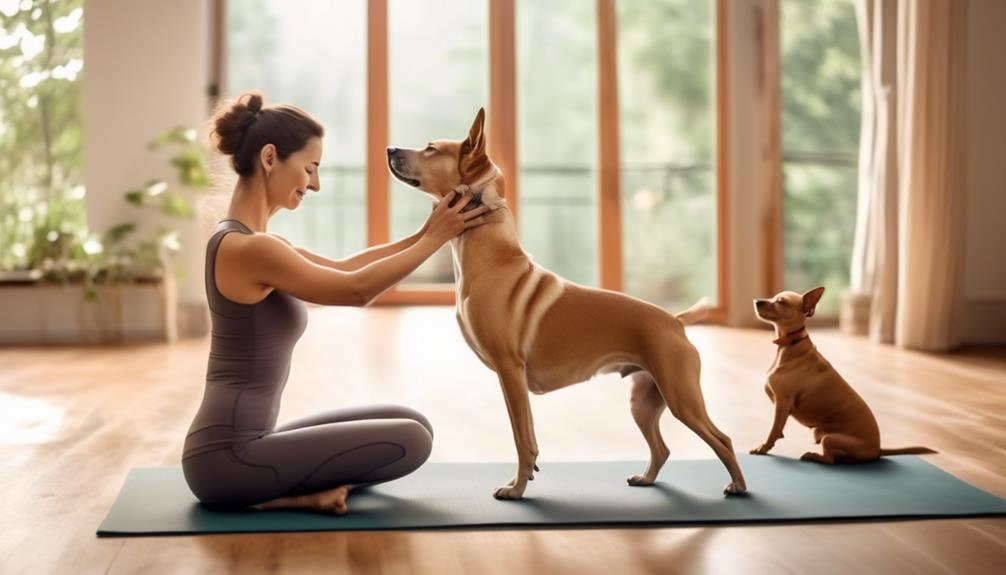
Building upon the foundation of Doga's origins, practitioners have discovered that incorporating their dogs into yoga sessions can greatly enhance their four-legged companions' flexibility. By engaging in various poses and stretches, dogs can experience improved agility and an increased range of motion. This is particularly beneficial for dogs who may have limited mobility due to age, injury, or other physical conditions.
To understand the impact of Doga on a dog's flexibility, let's take a closer look at some of the key benefits it offers:
| Benefit | Description |
|---|---|
| Improved Muscle Tone | Doga exercises target different muscle groups, helping to strengthen and tone the dog's body, thus enhancing flexibility. |
| Increased Joint Health | The gentle movements and stretches in Doga help to lubricate the joints, promoting better flexibility and reducing stiffness. |
| Enhanced Range of Motion | Through regular practice of Doga, dogs can gradually increase their flexibility, enabling them to move more freely and comfortably. |
The Mental Benefits of Doga for Your Pet

Incorporating Doga into your pet's routine can provide a range of mental benefits that contribute to their overall well-being. Dogs, just like humans, can experience mental health challenges such as anxiety and difficulty focusing. Doga, a combination of yoga and bonding exercises with your pet, can help address these issues.
Here are five mental benefits that Doga can offer your furry companion:
- Reducing Anxiety: Doga incorporates calming techniques such as deep breathing and gentle stretches, which can help dogs relax and reduce their anxiety levels. The presence of their human companion during Doga sessions also provides a sense of security and comfort.
- Improving Focus: Doga involves various poses that require dogs to concentrate on their body and balance. This practice can enhance their focus and attention span, leading to improved cognitive abilities.
- Stimulating the Mind: Doga incorporates mental stimulation exercises, such as puzzles and interactive games, to engage your pet's mind. These activities can prevent boredom, stimulate problem-solving skills, and promote mental agility.
- Enhancing Bonding: Doga involves physical contact and positive reinforcement, strengthening the bond between you and your pet. This deepened connection can boost your pet's overall well-being and provide them with a sense of security and trust.
- Promoting Mindfulness: Doga encourages both you and your pet to be present in the moment. Practicing mindfulness together can help reduce stress and create a sense of calmness for both of you.
Doga as a Bonding Experience for You and Your Dog
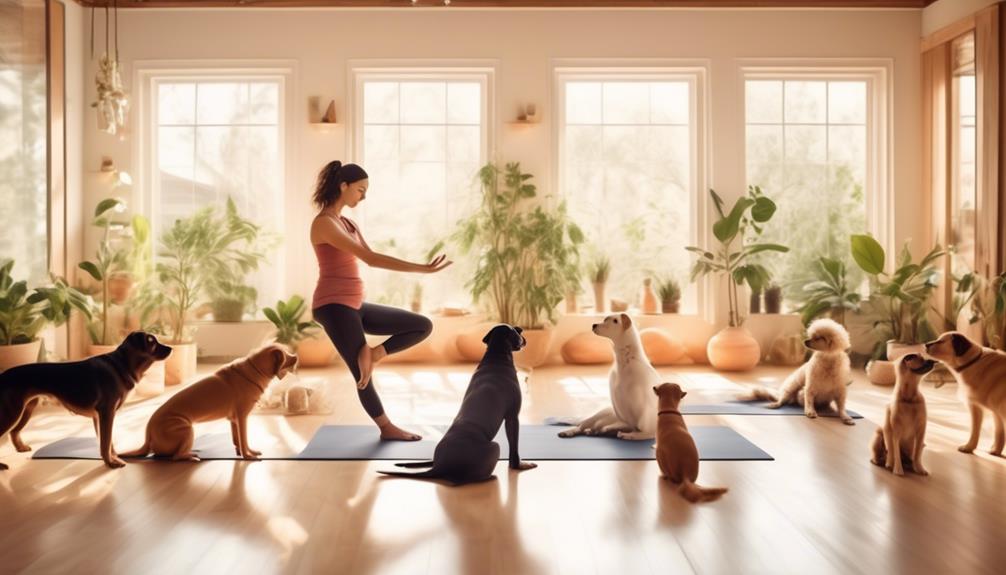
As you engage in Doga with your furry companion, you'll discover that it not only provides mental benefits for your dog but also serves as a powerful bonding experience between the two of you.
Doga, which combines yoga and dog training, offers a unique opportunity to strengthen the bond with your pet while improving their physical and mental well-being.
One of the key aspects of Doga that contributes to bonding is the use of bonding techniques during the practice. These techniques involve physical contact, such as gentle massage and stretching, which not only help to relax your dog but also create a sense of trust and connection between you and your furry friend. By engaging in these bonding techniques, you're able to establish a deeper level of communication and understanding with your dog, enhancing your relationship.
Moreover, Doga also has numerous health benefits for both you and your dog. The physical movements and stretching involved in Doga help to improve flexibility, coordination, and muscle strength in your dog. This can be particularly beneficial for older dogs or those with mobility issues.
Additionally, the relaxation techniques used in Doga can help to reduce stress and anxiety in both you and your pet, promoting overall well-being.
Tips for Getting Started With Doga

To successfully begin practicing Doga with your dog, it's important to follow these helpful tips:
- Start with basic obedience training: Before diving into Doga poses, ensure that your dog has a good grasp of basic commands like sit, stay, and lie down. This will make it easier for you to guide them during the practice.
- Create a calm environment: Find a quiet and peaceful space where you and your dog can practice without distractions. Soft music or calming scents can help create a relaxing atmosphere.
- Warm-up exercises: Begin each session with some gentle warm-up exercises for both you and your dog. This will help prepare your bodies for the stretches and poses that follow.
- Choose appropriate poses: Select poses that are suitable for your dog's size, breed, and physical condition. Avoid poses that put excessive strain on their joints or muscles.
- Be patient and flexible: Dogs may take time to adjust to Doga, so be patient and allow them to progress at their own pace. Modify poses as needed to accommodate their comfort level.
Getting started with Doga can bring numerous benefits for dogs, such as improved flexibility, reduced anxiety, and strengthened bond with their human companion. By following these tips, you can create a positive and enjoyable Doga experience for both you and your furry friend.
Doga Poses to Try With Your Dog

After ensuring that your dog has a good grasp of basic commands and creating a calm environment, it is time to explore some Doga poses to try with your furry companion. Doga, a combination of yoga and dog, is a practice that promotes relaxation and bonding between dogs and their owners. Engaging in Doga poses can have numerous benefits for your dog's overall well-being.
Here are some Doga poses for relaxation that you can try with your dog:
| Pose | Description |
|---|---|
| Downward Dog | Start with your dog in a standing position. Encourage them to stretch their front legs forward, while keeping their back legs straight and their head lowered. Hold this pose for a few breaths. |
| Puppy Pose | Have your dog lie down on their belly with their front legs extended forward and their rear end raised. This pose helps to stretch their back and shoulders. |
| Reclined Twist | Gently guide your dog onto their side and hold their paws together. This pose helps to release tension in their spine and hips. |
| Happy Baby | With your dog lying on their back, gently hold their paws and bring their knees towards their chest. This pose helps to open their hips and stretch their leg muscles. |
| Resting Pose | Allow your dog to lie down in a comfortable position and simply relax. This pose promotes overall calmness and relaxation.
Understanding the Potential Risks of Doga and How to Avoid Them
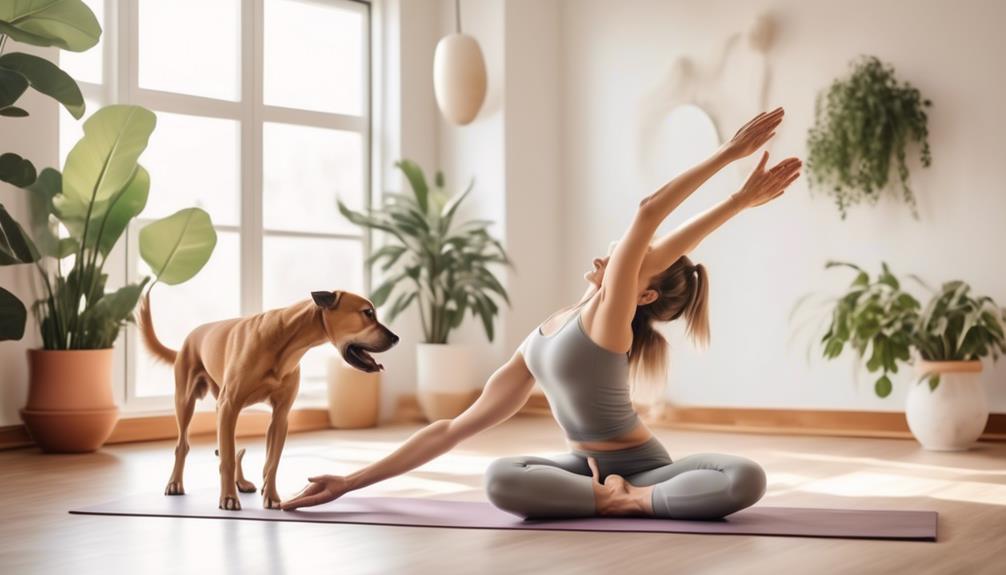
Understanding the potential risks of Doga and how to avoid them is crucial for ensuring a safe and beneficial practice for both dogs and their owners. While Doga can provide numerous benefits, it's important to be aware of the potential risks involved and take appropriate precautions to minimize them. Here are some key points to consider:
- Warm-up and cool-down: Just like humans, dogs need a warm-up and cool-down period before and after engaging in physical activities. Ensuring your dog is properly warmed up and cooled down can help prevent injuries.
- Avoid overexertion: Dogs, especially those with certain health conditions or older dogs, may not be able to handle intense Doga sessions. It's important to tailor the exercises to your dog's abilities and avoid pushing them beyond their limits.
- Mind your dog's body language: Dogs communicate through their body language, and it's important to pay attention to any signs of discomfort or stress during Doga sessions. If your dog is showing signs of distress, it's best to stop the activity and consult a veterinarian.
- Use proper equipment: Using the right equipment, such as non-slip mats or blankets, can help prevent slips and falls during Doga poses. Additionally, using a well-fitted harness instead of a collar can provide better control and prevent neck injuries.
- Consult a professional: If you're new to Doga or unsure about certain poses, it's recommended to consult a professional Doga instructor who can guide you and ensure that you and your dog are practicing in a safe manner.
Frequently Asked Questions
Can Doga Be Practiced by Any Breed of Dog?
Doga benefits for different dog breeds vary depending on their size, temperament, and physical abilities. To introduce doga to your dog, start with gentle stretches and gradually increase the difficulty level to ensure their safety and enjoyment.
Is It Necessary for the Owner to Have Previous Yoga Experience in Order to Practice Doga?
It is not necessary for the owner to have previous yoga experience in order to practice doga. The owner's role in doga is to guide and support their pet. Doga can benefit pets by promoting relaxation, increasing flexibility, and strengthening the bond between owner and pet.
Are There Any Age Restrictions for Dogs to Participate in Doga?
There are no age restrictions for dogs to participate in doga. However, it is important to ensure that the practice is safe for puppies. Doga can also be beneficial for senior dogs by promoting flexibility and relaxation.
Can Doga Help With Behavioral Issues in Dogs?
Doga, a practice combining yoga and dog training, has been shown to help dogs with behavioral issues. It can reduce anxiety and increase calmness in dogs, including senior ones, offering numerous benefits for their overall well-being.
Are There Any Specific Health Conditions or Injuries That Would Make a Dog Ineligible for Doga?
Not all dogs may be eligible for doga due to certain health conditions or injuries. However, for those who can participate, doga can provide a range of benefits, including improved flexibility, reduced stress, and enhanced bond with their owners.



